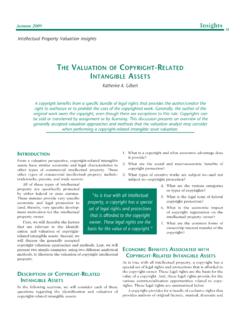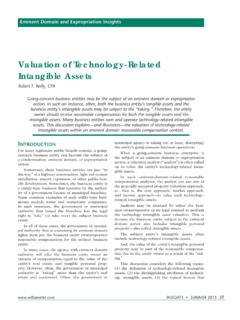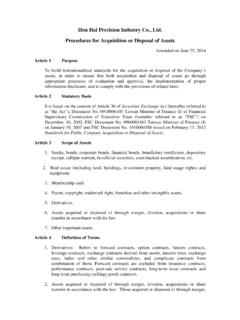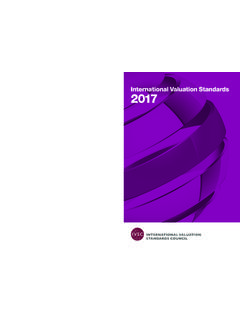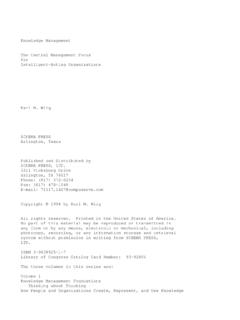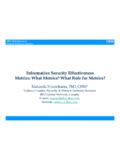Transcription of Valuation of intangible assets - OECD.org
1 Valuation of intangible assets International Valuation Standards Jean-Florent R rolle, IVPB IVSC in brief IVSC stands for International Valuation Standards Council Non profit organization created in 1981 and restructured in 1987-1988 Develop robust and transparent procedures for performing international valuations through a single set of globally recognized Valuation standards 3 boards: Board of trustees responsible for strategic direction and funding Standards Board issues international Valuation standards Professional Board issues guidance and promote professional standards and training Open to users, providers, professional institutes, educators and regulators of Valuation services 2 OECD - November 9, 2010 International Valuation Standards Valuation is an estimate based on judgment.
2 IVS do not tell people how to value IVS set a robust framework for the exercise of judgment Identify financial conventions Describe basics of commonly used Valuation methodologies Sets the minimum information to be included in a report IVS are applicable to all Valuation purposes (not only IFRS) and types of assets General standards Application Standards (specific purposes) assets Standards (matters that influence the value of different types of assets ) 3 OECD - November 9, 2010 intangibles Valuation in IVS IVSC has worked extensively on the subject ED Revised international Valuation guidance note n 4- Valuation of intangible assets (January 2009) ED Proposed new International Valuation Guidance Note No.
3 16 - Valuation of intangible assets for IFRS Reporting Purposes (January 2009) ED IVS IVS 301-02 Valuation of intangible assets (June 2010) In 2011 IVSC will issue its final IVS and a TIP on intangibles Valuation 4 OECD - November 9, 2010 Definition of intangible assets Non monetary asset that manifests itself by its economic properties No physical substance, but Grants rights and economic benefits to its owner Identifiable if it is either : Separable, or Arises from contractual or legal other legal rights Goodwill is an unidentifiable intangible asset : residual amount ..remaining after the value of the identifiable assets adjusted for liabilities have been deducted from the value of the business 5 OECD - November 9, 2010 Examples of intangibles Marketing Related Trademarks Trade names Certification marks Trade dress (unique color, shape or package design) Internet domains Non-compete agreements.
4 Customer or supplier related Advertising agreements Licensing, royalty agreements Servicing contracts Franchise agreements Customer relationships Customer lists .. Technology Related Contractual or non contractual rights to use : Patented or unpatented technologies Data bases Formulae Designs Softwares Processes Recipes Artistic related Royalties from artistic works : Plays Books Films Music Royalties from non-contractual copyright protection 6 OECD - November 9, 2010 Valuation approaches for intangible assets Direct market comparison with transaction involving identical or similar assets Income approach : value is determined by reference to present value of income, cash flows or cost savings generated by the asset Relief-from royalty.
5 Value of the hypothetical payments that would be saved through owning the asset compared with licensing it from a third party Premium profit method : comparison of forecasted profits earned by a business using the asset with those that would be earned without Excess earning method : Present value of the cash-flows attributable to the intangible asset after excluding the proportion of the cash flow attributable to other assets (contributory assets ) Single period Multi period excess earnings method (MPEE) Cost approach for internally generated intangible assets that have no identifiable income streams Replacement cost Cost of developing a similar asset 7 OECD - November 9, 2010 Practical Valuation issues Heterogeneous nature of intangible assets Insufficient market data (or wide range) makes it difficult to rely on only one Valuation method Direct market approach delicate to use Adjustments frequently needed (subjectivity risk)
6 Estimating the remaining useful life of the asset Consider legal, technological, functional and economic factors Forecasting cash flows and measuring risk Identify cash flows specifically attributable to the asset (separability issue) Uncertainty on future cash flow (risk factor issue) 8 OECD - November 9, 2010 Conclusion Valuation is more an art than a science Nature of the exercise : replicate the market behavior Complexity and uncertainty of assets Evolution of Valuation techniques As it is a highly subjective exercise, standards are useful to : Frame the expert judgment Set the proper due diligence process Define the type of disclosure The quality of a Valuation rests on the expertise, the internal processes and the independence of the valuer, all elements to be checked by the company 9 OECD - November 9, 2010










